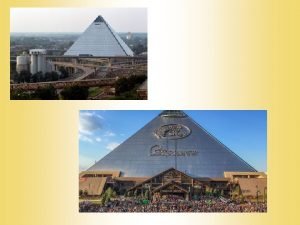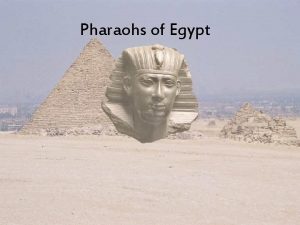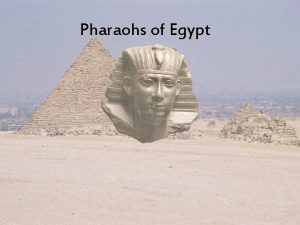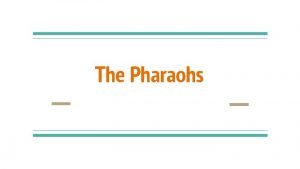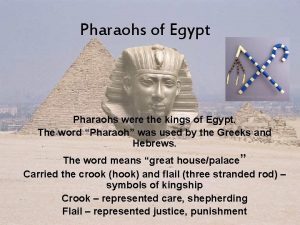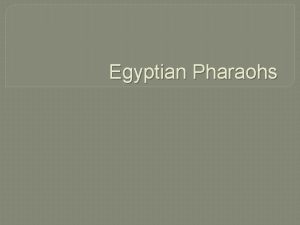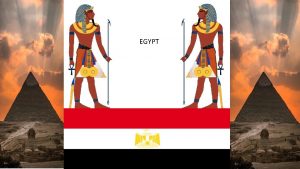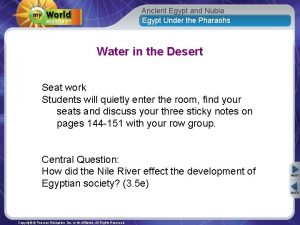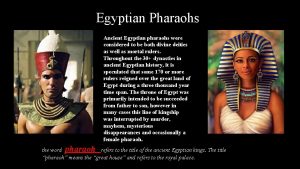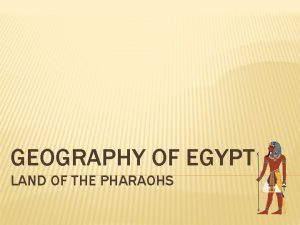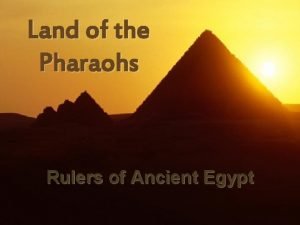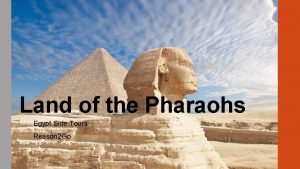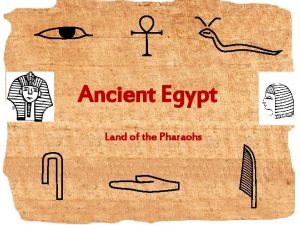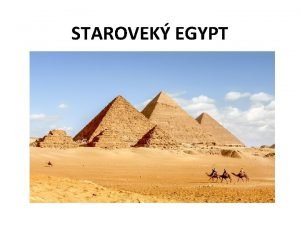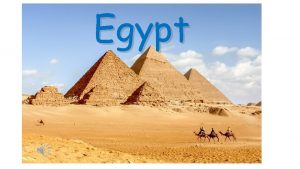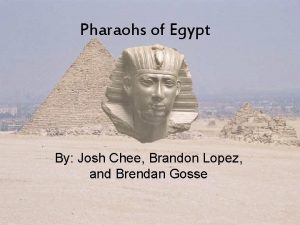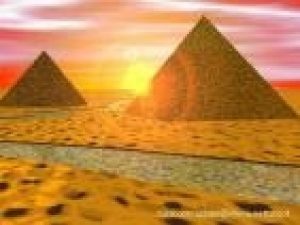Egypt land of the pharaohs The Rise of






















- Slides: 22

Egypt : land of the pharaohs

The Rise of Cities (do not write- review) • Farming surpluses lead to population increase • Villages turned to cities – 5, 000 to 30, 000 residents Ancient Ruins • Each emerged in a river valley Modern Cairo


GEOGRAPHY Capital: Cairo President: Hosni Mubarak Area: 386, 900 sq. miles Population: 62, 931, 000 Religion: Muslim 94%, Christian and Jewish 6% Languages: Arabic, English, French

The Nile River • 4, 160 miles • Predictable floods provide crops with water and black silt deposits • Flows north to the Mediterranean sea

The Sahara is the largest desert in the world- over 3. 5 million square miles- as large as the United States Quickwrite: How did the Geography of Egypt affect the country socially?

Egyptian Government • Set up to maintain the food supply • The pharaoh (king) established the laws • The vizier is 2 nd in command controls everything that the pharaoh cannot • The “officials” maintained the law

Economy • Barter was the main form of trade, money was not used until much later. • Most people were farmers • Needs: grain, fish, linen, and mud bricks

Technological Contributions Irrigation Systems provide water for Cairo and other cities.

The Pyramids Stone statues


Writing: Hieroglyphs Streaming video • Invented out of necessity to record trade transactions • Originally used pictograms

The Rosetta Stone • Discovered by Jean Champollion in early 1800’s • A flat black stone with the same message written in hieroglyphics, demotic, and Greek • Helped scholars understand hieroglyphics

OTHER INVENTIONS: • Calendar • Clock • Papyrus

Rise of Social Classes farmers cook • Ruling class – Pharaohs considered godlike • Scribes – Priests that kept records for the pharaoh servant girl

Rise of Social Classes (cont. ) cook • Merchants farmers – Traders • Artisans – Men who made objects with their hands • Slaves – Captured in battle servant girl

Religion • Earliest practices included animal worship • Polytheistic ( belief in many gods) – Land sun gods – Examples: hunting, child-bearing, underworld, love, craftsmen, creation • Built temples for sacrifices and worship • Pharaoh: Son of Re, the sun god

Osiris, Isis, Set, and Horus

Afterlife • Believed they could be resurrected • Built pyramids to bury great pharaohs • Book of the Dead is a collection of spells that helped the dead pass through the next life

Afterlife • Buried each person with items that would help them in the next world • Common items: food, bowls, combs, furniture, small statues to do work for them, boats

Mummification • Ka – Ka waits for a body to return to – Spirit created when each man is born – Mummify to preserve a sound body for the ka to return to – 70 day process – Improper embalming leads to second, true death

 What did khufu accomplish
What did khufu accomplish Upper egypt and lower egypt
Upper egypt and lower egypt Rise and rise again until lambs become lions
Rise and rise again until lambs become lions Tricky dick
Tricky dick Rise and rise again until lambs become lions
Rise and rise again until lambs become lions Rise and rise again until lambs become lions origin
Rise and rise again until lambs become lions origin An area of land largely enclosed by higher land
An area of land largely enclosed by higher land Identify the landform
Identify the landform Diễn thế sinh thái là
Diễn thế sinh thái là Vẽ hình chiếu vuông góc của vật thể sau
Vẽ hình chiếu vuông góc của vật thể sau Ng-html
Ng-html Thế nào là giọng cùng tên? *
Thế nào là giọng cùng tên? * Làm thế nào để 102-1=99
Làm thế nào để 102-1=99 Lời thề hippocrates
Lời thề hippocrates Khi nào hổ mẹ dạy hổ con săn mồi
Khi nào hổ mẹ dạy hổ con săn mồi Glasgow thang điểm
Glasgow thang điểm đại từ thay thế
đại từ thay thế Quá trình desamine hóa có thể tạo ra
Quá trình desamine hóa có thể tạo ra Công thức tiính động năng
Công thức tiính động năng Thế nào là mạng điện lắp đặt kiểu nổi
Thế nào là mạng điện lắp đặt kiểu nổi Các loại đột biến cấu trúc nhiễm sắc thể
Các loại đột biến cấu trúc nhiễm sắc thể Vẽ hình chiếu đứng bằng cạnh của vật thể
Vẽ hình chiếu đứng bằng cạnh của vật thể Nguyên nhân của sự mỏi cơ sinh 8
Nguyên nhân của sự mỏi cơ sinh 8

